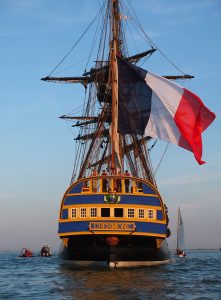Mount Vernon is proud to serve as the 2015 conference host and co-sponsor for the Sons of the American Revolution (SAR)’s Annual Conference on the American Revolution. Other partner organizations include the Richard Lounsbery Foundation and Friends of Hermione – Lafayette in America. This conference will highlight the well-known alliance between the United States and France as well as lesser-known relationships with the Netherlands, Spain, and other Europeans states and individuals. The event will feature leading international scholars, including: Douglas Bradburn, Olivier Chaline, Robert Crout, Jonathan Dull, Kathleen DuVal, Victor Enthoven, Paul A. Gilje, Sylvia Hilton, Jean-Marie Kowalski, Andrew Jackson O’Shaughnessy, Julia Osman, Munro Price, Marie-Jeanne Rossignol, Patrick Villiers and Timothy Walker.
The conference will be held on June 12-14, 2015. Click here for registration details and please enjoy this short article about Marquis de Lafayette, European Friend of the American Revolution:
At first glance, Gilbert du Motier—better known as the Marquis de Lafayette— might seem an unlikely supporter of George Washington. Born in 1757, he came from one of France’s oldest families. His ancestors served in the Crusades and alongside Joan of Arc. When Gilbert was two, his father died fighting in the Seven Years’ War. Upon the death of his mother when he was eleven, Lafayette inherited one of his nation’s largest fortunes. But the young nobleman was never impressed with status or riches, longing instead for military glory. He won a captain’s commission in the French army and was appointed to the Black Musketeers in 1763.
In 1775, Lafayette’s life took an unexpected turn when he lost his commission when the government reduced military spending. Called to the city of Metz for militia duty, he attended a dinner with the British Duke of Gloucester. The Duke mocked the American colonists for their revolutionary beliefs in the equality of mankind and the right of people to rule themselves. The Duke further explained how the colonists had organized the Continental Army under the leadership of General George Washington. Lafayette would always remember this dinner as the turning point of his life. “My heart was enlisted,” he later confessed in his memoirs, “and I thought only of joining my colors to those of the revolutionaries.” Lafayette studied the ideals of the American Revolution and planned to enlist in the Continental Army.
Silas Deane was a representative of the Continental Congress sent to France to recruit officers. Even though Lafayette was only nineteen and had no experience in war, Deane offered him a commission. King Louis XVI ordered Lafayette to remain in France, but the defiant young nobleman ignored him and set sail for America in early 1777. When he finally arrived in Philadelphia, Congressmen James Lovell of Massachusetts refused to receive him, saying that Americans were tired of ambitious Frenchmen seeking glory. But upon realizing how wealthy and well-connected Lafayette actually was, and recognizing his sincere support for the American cause, Lovell recommended Lafayette’s appointment as a Major-General.
Lafayette proceeded to General Washington’s camp along Brandywine Creek south of Philadelphia in September 1777. Washington was immediately taken with the young Frenchman, especially when the Marquis explained, “I am here to learn, not to teach.” Washington ordered Lafayette to join General John Sullivan’s forces who were in a desperate fight on the army’s right. When Sullivan finally retreated, Lafayette reluctantly went with him, realizing only later that he had been shot in the leg. Washington sent his own surgeon to care for him, and when Lafayette was taken to the hospital the General told the doctors to, “Treat him as if he were my son.”

After Lafayette recovered, he became a valued member of Washington’s close-knit military family. He in turn came to admire Washington’s leadership more each day, especially during the terrible winter at Valley Forge. Lafayette was overjoyed when news of the French alliance arrived in early 1778.
In June 1778, Lafayette returned to France hoping to win more support for the united colonies. But while he was feted as a hero, he was not placed at the head of the French army. The Count de Rochambeau was chosen instead. By the summer of 1781, Lafayette was back in America, and Washington sent him to Virginia to stop British raids along the James River. When Cornwallis’ forces arrived in Virginia, Lafayette harassed the British general until Washington and Rochambeau could lay siege to him at Yorktown. In October 1781, there was no prouder soldier at Cornwallis’ surrender than Lafayette.
Lafayette again returned to France as a national hero. Three years later on a tour of the United States he visited Washington at Mount Vernon. Lafayette remembered, “Our meeting was very tender and our satisfaction was mutual.” Like Washington, he favored the creation of a strong central government. But unlike Washington he recommended an immediate end to slavery. Back in France, Lafayette helped launch the French Revolution in 1789. He served in the National Assembly and drafted the Declaration of the Rights of Man. He proudly sent the key to the Bastille to Washington, who was then serving as the first President of the United States.
Lafayette fled from France when the revolution turned violent. He was imprisoned at Olmütz by the Austrians who considered him a dangerous radical. He was finally set free and settled at LaGrange, his wife’s family estate near Paris, nicknamed the Mount Vernon of France.
One of Lafayette’s greatest joys in his later years came in 1824, when he made a triumphant tour of the United States. At Mount Vernon he went alone to visit the grave of George Washington, returning to his carriage with tears in his eyes. Lafayette remained a defender of democratic ideals until his death in 1834.
ATTEND THE CONFERENCE:
The Marquis de Lafayette and the European Friends of the American Revolution
Highlighting the well-known alliance between the United States and France as well as lesser-known relationships with the Netherlands, Spain and other European states and individuals.
June 12-14, 2015
Mount Vernon
Click here for registration and schedule details














One thought on “The Marquis de Lafayette, European Friend of the American Revolution”
Two interesting facts not noted in the article. 1-Portraits of George Washington and the Marquis de Lafayette flank the Speakers Rostrum in the U.S. House of Representatives, and 2-Lafayette was the first foreign dignitary to address the U.S. House of Representatives on 10 December 1824.